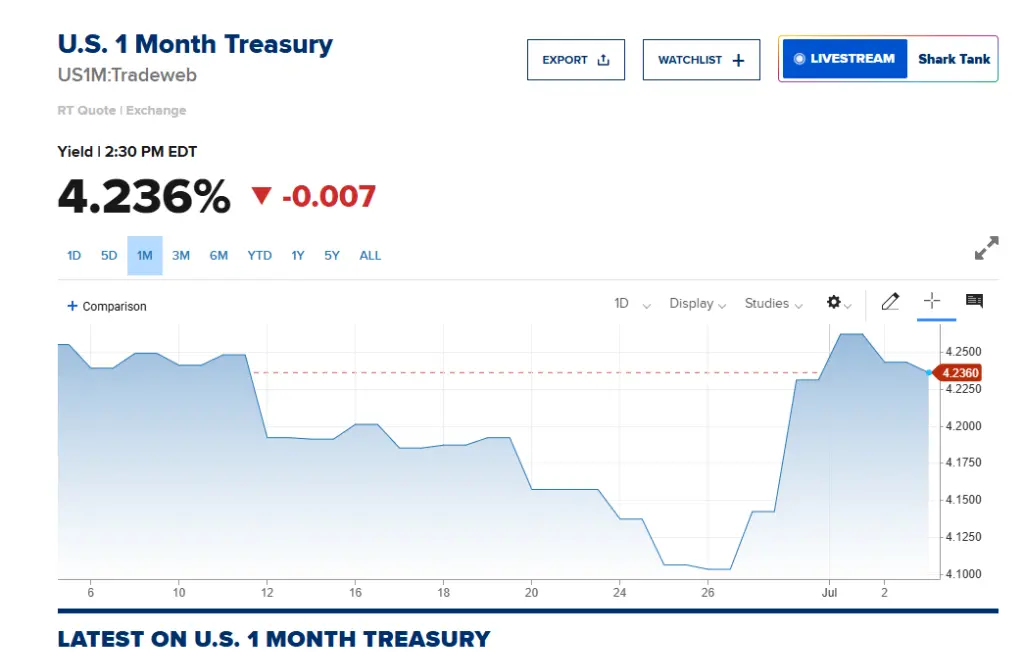Author: Wall Street News
With the Trump administration's large-scale tax cuts and spending bill officially implemented, the U.S. Treasury may soon initiate a "supply flood" of short-term government bonds to offset future fiscal deficits amounting to trillions of dollars.
The market has already begun to respond to the anticipated supply pressure. Concerns over an oversupply of short-term government bonds have been directly reflected in prices—the yield on one-month short-term government bonds has seen a significant increase since this Monday. This marks a complete shift in market focus from earlier concerns about the sell-off of 30-year long bonds to the front end of the interest rate curve.

Trillion-Dollar Deficit Looms: U.S. Short-Term Bond Market to Face "Supply Flood"
The implementation of the new bill brings with it a grim outlook for future fiscal conditions. According to estimates from the nonpartisan Congressional Budget Office (CBO), the bill will add up to $3.4 trillion to the national deficit for the fiscal years 2025 to 2034.
In the face of enormous financing needs, issuing short-term government bonds has become a cost-effective choice favored by decision-makers.
First, from a cost perspective, while the yields on short-term government bonds with maturities of one year or less have climbed above 4%, they remain significantly lower than the nearly 4.35% issuance rate of ten-year bonds. For the government, with interest expenses already becoming a heavy burden, a lower immediate financing cost is a strong attraction.
Second, this aligns with the current administration's clear preference. Previously, President Trump himself expressed a preference for issuing short-term notes rather than long-term bonds. Treasury Secretary Mnuchin also stated to the media that increasing the issuance of long-term bonds "makes no sense" at this juncture.
However, this strategy is not without risks. Relying on short-term financing may expose borrowers to the volatility of future financing costs or higher risks. An anonymous Canadian bond portfolio manager stated:
"Anytime you finance a deficit with extremely short-term notes, there is a risk of shocks occurring, which could put financing costs at risk."
For example, if inflation suddenly rises and the Federal Reserve has to consider raising interest rates, the cost of short-term financing will increase as Treasury yields rise. Additionally, an economic recession and shrinking economic activity could lead to reduced savings, thereby lowering demand for short-term notes.
Supply and Demand Showdown: Can $7 Trillion in Liquidity Absorb the Bond Issuance Surge?
As the supply floodgates are about to open, the market's capacity to absorb this supply has become a new core issue. Currently, the market seems confident, drawing strength from the massive liquidity built up in the money market.
First, looking at the supply side. The U.S. Treasury Borrowing Advisory Committee (TBAC) currently recommends that the proportion of short-term government bonds to total outstanding debt should be around 20%. However, Bank of America's interest rate strategist team predicts that to absorb the new deficit, this ratio may soon rise to 25%. This means the market needs to prepare for a supply of short-term notes that far exceeds the official recommendation.
As a result, the market's focus has dramatically shifted. Back in April and May of this year, investor anxiety was centered on the sell-off of 30-year long bonds and the risk of their yields soaring above 5%. Now, the spotlight has completely turned to the other end: will short-term government bonds face new turmoil due to oversupply?
Now, looking at the demand side, Matt Brill, head of North American investment-grade credit at Invesco Fixed Income, believes that the $7 trillion in money market funds in the market represents a "sustained demand" for front-end debt, and the U.S. Treasury seems to be aware of this.
Mark Heppenstall, president and chief investment officer of Penn Mutual Asset Management, is even more optimistic, stating:
"I don't think the next crisis will come from short-term government bonds; there are many people looking to put capital to work, especially when real yields look quite attractive. You might see some pressure on short-term bond rates, but there is still a lot of cash flowing in the market.
If problems do arise, the Federal Reserve will find a way to support any supply-demand imbalance."
免责声明:本文章仅代表作者个人观点,不代表本平台的立场和观点。本文章仅供信息分享,不构成对任何人的任何投资建议。用户与作者之间的任何争议,与本平台无关。如网页中刊载的文章或图片涉及侵权,请提供相关的权利证明和身份证明发送邮件到support@aicoin.com,本平台相关工作人员将会进行核查。



